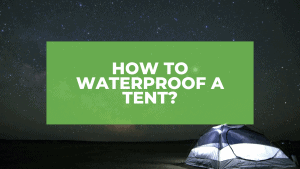The rain is right whenever it falls. What can be wrong is where it finds you.
Camping?
That’s great because I believe you have a waterproof tent that won’t allow drizzles into it, don’t you?
If your answer is no, shelve your worries — this piece is drafted for you.

In this article, you’ll learn how to waterproof a tent so that it looks and feels safe, leave alone lasting long. Also, you’ll learn how to keep your tent water-safe at the right time — so that you don’t fall a victim of drip-drip-drip at rush hour.
As you read through the article, you’ll also learn a lot more facts that I doubt you had at your fingertips before.
Quick Navigation
When Does It Need Waterproofing?
It’s wise to waterproof your tent as often as it leaks, but doing so when it doesn’t leak isn’t a sin, especially after a trip or two.
However, when your tent is new from the retailer, it’s always solidly waterproof, and you shouldn’t bother to work on it at this point in time.
When you see water seeping into the interior parts of your tent, check if it’s actually leaking. Most of the time, you should fix your eyes on the seams, which are the most common leak spots.
Also, check out for a leak through the rainfly, walls, and the floor. Please don’t let condensed water from your breath fool you that it’s a leak. Knowing where your tent is leaking from will make you know the right materials (and their size) to use for repair.
The Guide:
Your tent will leak either from the rainfly, seams, or fabric. I’ll go through how to waterproof each of these parts.
Waterproofing The Seams
Seams are the junctions at which your tent’s fabric meet one another. Seams are heavily stitched, and they have a heavy waterproof coating. Nevertheless, they are prone to myriads of damages that can easily corrupt their waterproof quality to let water into your tent. Here’s how to waterproof your seams.
- Clean your seams using a piece of cloth and rubbing alcohol, ensuring that you remove any particles that are falling off. Leave the tent in the open air to dry.
- Use a paintbrush or applicator to apply a thin layer of seam sealant along all the seams. Make sure that the sealant you’re using is of the best quality.
- Let the sealant dry for 12 hours.
- In case the seam is torn apart, you’ll need to stitch it up first, and the style of stitching will depend upon the size of the tear. Smaller tears can be stitched without patches, while larger ones will need patches. In case you use patches, use very strong ones.
Waterproofing The Rainfly And Floor
Both your tent’s rainfly and floor have a urethane coating finish that protects them from water. When damaged, you’ll notice flakes on the two surfaces, and this means that you should apply a urethane coating again. Here are the steps.
- Spread your tent or rainfly on a dry surface with the flaking surface facing up.
- Scrub off the flaking bits using a sponge, taking care not to destroy the tent with friction. After all, the flakes are off, use rubbing alcohol, and the sponge to clean the remaining surface again.
- Let it dry for a few minutes, preferably twenty to thirty.
- It’s now time to apply your sealant. And here, you have to go by the manufacturer’s instructions. Follow the instructions on how to use the tent sealant. You also have to make sure that you have the best sealant here. Clean any excess sealant.
- Leave the fly and or floor to dry for 24 hours before you use the tent.
Applying The Durable Water Repellent (DWR)
The DWR is found on the outside layer of your tent and rainfly. The coating has little adhesion for water, and that’s why water beads up on its surface. It may wear out so that water starts finding its way into your tent. To curb this, you have to apply a new DWR layer. Here’s how it’s done.
- On a sunny day, choose an open ground where you can work without any distractions. Take your tent there and spread it evenly on the ground. If it’s dirty, use a sponge to scrub it a bit while washing it.
- Without letting it dry, apply the correct DWR spray on the whole surface area of your tent. Make sure you’re using the right spray. Also, ensure you abide by all the instructions on the spray’s label.
- Wipe off all excess coating using a piece of cloth.
- Before storing or using the tent, let it dry in air for the next 24 hours.
Remember To:
Check Your Tent’s Waterproof Rating
Waterproofness is measured by HH (hydrostatic head) units. For example, 2000 mm HH means that the tent can withstand 2000mm of water on its surface before it starts to leak.
Once you know this, you can decide on where to camp and where not to, based on your tent’s safety.
Stop Relying Upon The Weather
Don’t assume that you know the weather patterns in the area you shall camp and prepare only according to your assumptions. Your camping happiness may turn sour.
Always waterproof your tent in advance — better be safe than sorry.
Use The Right Products For Waterproofing
Tents are made of different materials that need different waterproofing products and instructions. For example, polyurethane- and silicone-coated fabrics need different sealers, so be sure to check your tent’s material and its appropriate sealant.
The Bottom Line
You don’t have to break the bank in the name of seeking for waterproofing services at a “professional” service provider. You can always DIY at home.
This article has all the steps you need explained in the right order. So before you set out to the campground, make sure you check your tent for any leak indicators (including flakes and rips) and waterproof it in advance.
Happy camping, pals!



